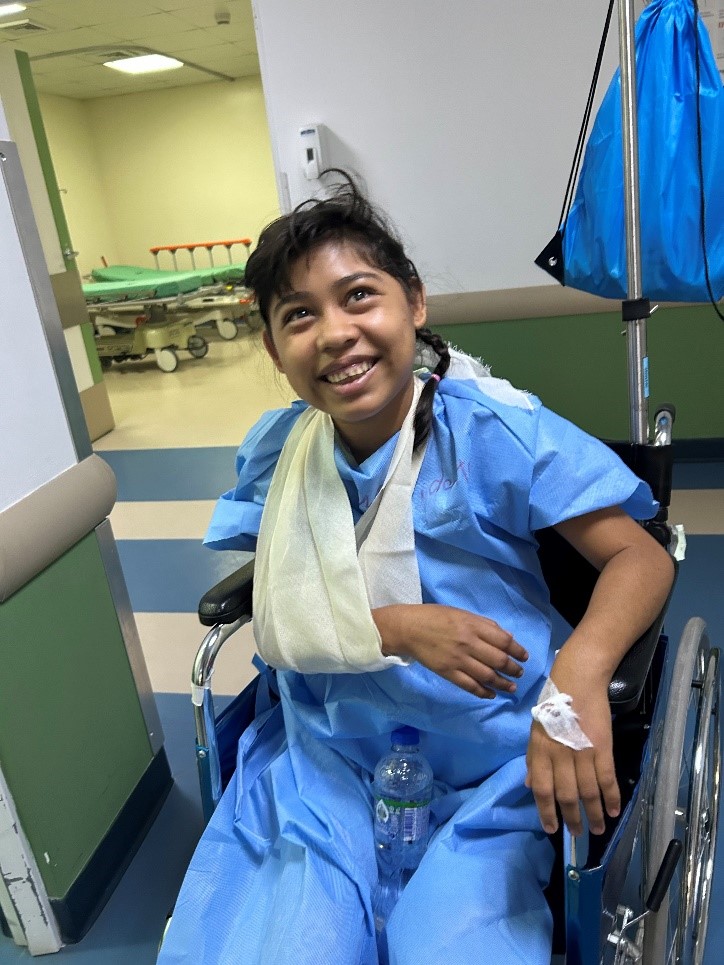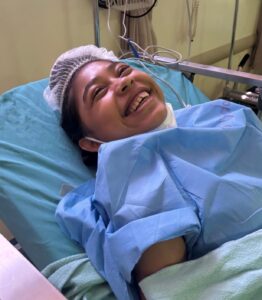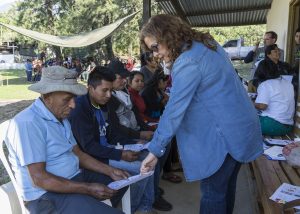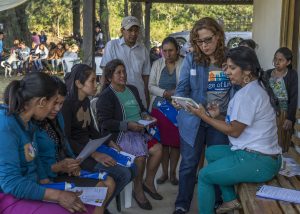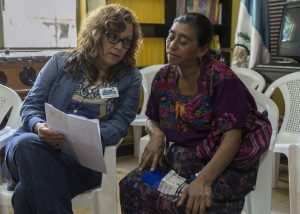Bridge of Life Up Close
Breaking News-letter: Syria and Lebanon

|
BOL’s Director of Technical Programs, Christopher E. Atwater Sr., recently returned from the Middle East after performing assessments and water treatment training for dialysis clinics in Syria and Lebanon. |
|||
|
Our team at Bridge of Life strongly believes that everyone deserves access to quality healthcare services, and we’re committed to supporting partners around the world where specialized expertise is required. In several dialysis centers, Chris assessed infection control, clinical practices, water treatment systems and technical operations. The goal was to ensure that our dialysis capacity partners can provide safe, effective treatment even in the most challenging circumstances. Our History: Since 2015, Bridge of Life has partnered with free Syrian medical professionals, building lasting relationships with biomedical technicians, nurses, and nephrologists.
|
She Lost Her Sight, Not Her Spark – Help Melissa See Again
Meet Melissa – Melissa is a bright and curious 21-year-old from Guatemala who lights up every room with her energy. When we first met her, she playfully repeated her phone number in five different languages just to make us smile. Despite facing tremendous health challenges, her spirit remains unbroken—she’s full of questions about the world and shares her joy with a radiant, beaming smile.
Melissa has lived with diabetes since childhood, and it has slowly taken a toll on her eyesight. Nearly blind now, her family had begun raising money for eye surgery—with help from their church, neighbors, and friends. But last September, just before her surgery, tragedy struck. On the way to a pre-op appointment, a truck ahead of her car dropped lumber onto the road. Melissa’s vehicle was hit. She suffered a serious leg injury and spent weeks in the hospital recovering. She shared that the medication damaged her kidneys and she now lives with end stage renal disease.
Her family had to use the money saved for her eye surgery to cover her emergency care.
Today, Melissa navigates the world with a cane as her vision continues to decline. Yet through it all, her spirit remains bright. There’s still hope for her to see clearly again—and that’s where we come in.
We’re raising $2,000 to help cover the cost of Melissa’s much-needed eye surgery.
Please join us in making a difference, and let’s give Melissa the chance to see the world again….clearly, brightly, and fully.
Your donation, no matter the size, will bring Melissa one step closer to seeing the world that she loves to explore and learn about. Together, we can help Melissa see again. Thank you for your compassion and generosity.
A New Lease on Life – Our Work in Haiti
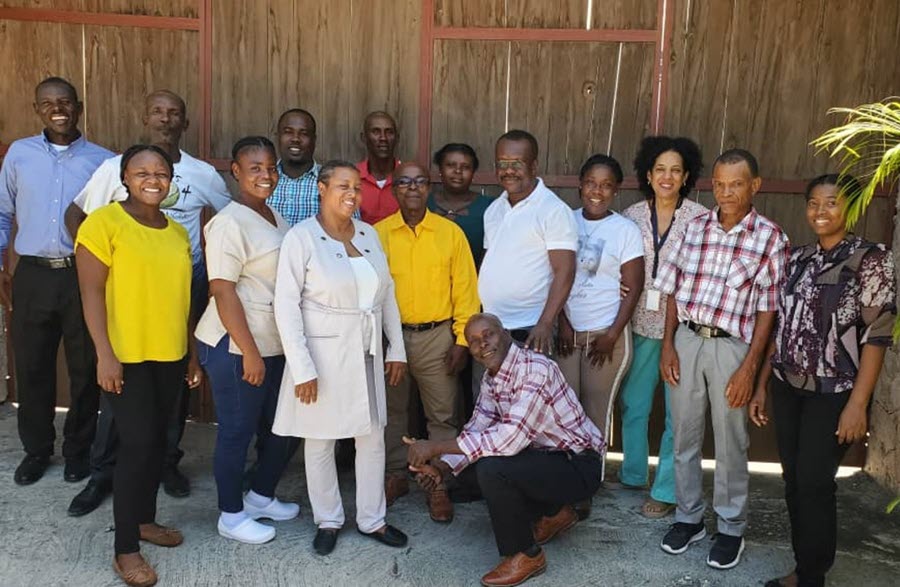
View our Haiti 2025 Photo Album
In January, BOL successfully completed a 3-year project focused on improving healthcare delivery in Haiti. Because of the political unrest and ongoing challenges, Haiti has become an increasingly difficult place to work. These obstacles affected the project timeline, scope and ability to get supplies, but Bridge of Life and our on-the-ground partner, NECH-CIECH, remained committed to serving and supporting community members of the Port Salut region.
 Through this project, we screened 1,770 community members for hypertension, diabetes, and kidney disease. Additionally, we organized 293 health-focused activities that engaged over 5,800 attendees, promoting wellness and disease prevention community wide.
Through this project, we screened 1,770 community members for hypertension, diabetes, and kidney disease. Additionally, we organized 293 health-focused activities that engaged over 5,800 attendees, promoting wellness and disease prevention community wide.
To support ongoing care to those that need it most, we connected 570 high-risk individuals with Community Health Workers who provided continuous education, home visits, and health monitoring. In less than a year, 20% of participants saw improved health outcomes, while 62% maintained stable conditions. Although we anticipated stronger outcomes, we must keep in mind the constant stress and uncertainty community members are experiencing every day.
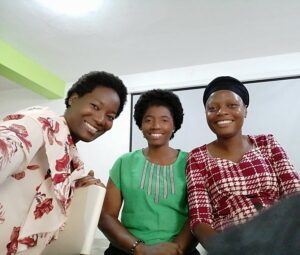 This impact highlights the power of targeted health education and strong local healthcare partnerships in driving meaningful community health improvements, even in resource-limited settings. Thank you to NECH-CIECH for persevering and thank you to the Cencora Impact Foundation for ensuring that this program was completed.
This impact highlights the power of targeted health education and strong local healthcare partnerships in driving meaningful community health improvements, even in resource-limited settings. Thank you to NECH-CIECH for persevering and thank you to the Cencora Impact Foundation for ensuring that this program was completed.
Please read Mrs. Louis’ story below highlighting her involvement in this program!
A New Lease on Life
At 62 years old, Mrs. Louis, originally from Port Salut, is married and the mother of three children.
Out of curiosity, she accepted a friend’s invitation to attend a yoga club organized by a community health worker (CHW) associated with NECH-CIEH. Shortly after, Mrs. Louis formally joined the program. She attended sessions at least twice a week and quickly became part of the program.
Diabetic and hypertensive, Mrs. Louis’ fragile health had put an end to her professional activities as a merchant. For her, undertaking a physical exercise program marked a turning point in her life. Previously unable to walk, she can now do so with ease. She struggled to sit due to pain, but now she can do so effortlessly. Even walking uphill once seemed impossible, but today she can do it without getting short of breath.
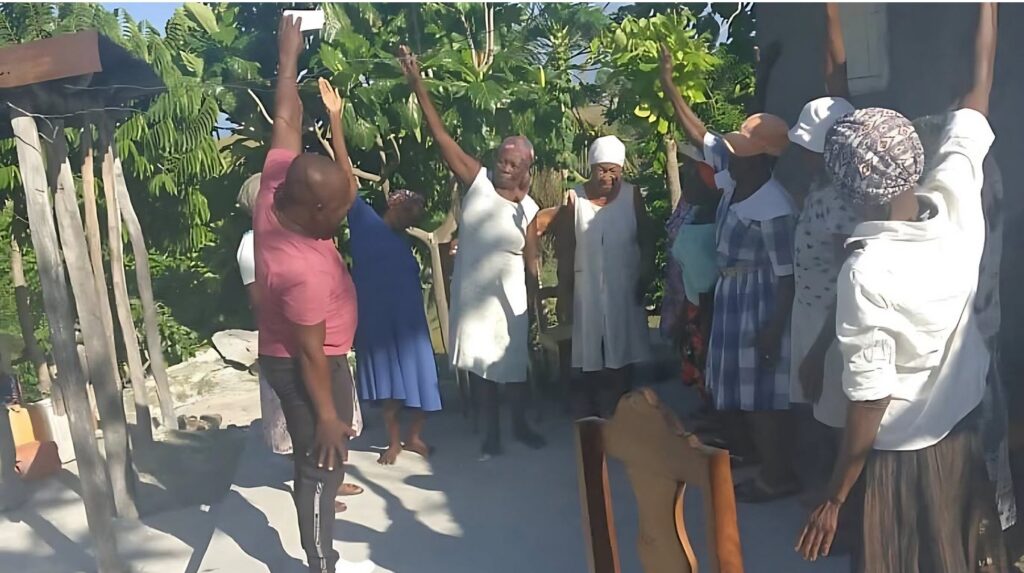 “I can stand on my own two feet. I can do everything with my body thanks to the exercises,” she says enthusiastically.
“I can stand on my own two feet. I can do everything with my body thanks to the exercises,” she says enthusiastically.
Mrs. Louis has also observed the benefits of exercise combined with medical care among other participants in the program, noting that the combination of medication and exercise has brought them relief and, like her, has allowed them to return to their daily activities. Prior to participation in the program, they also struggled with mobility or sitting for long periods of time. Some even saw their blood sugar levels decrease thanks to live-saving medication.
Mrs. Louis strongly hopes the activities will continue, as many participants cannot afford to access medical treatment due to financial constraints. For them, this program plays a vital role in bridging the gap between their homes and the hospital. It helps them measure and control their blood pressure and blood sugar levels and better manage their illnesses. Inspired by her progress so far, Mrs. Louis has even started searching for exercise videos on YouTube to keep improving her health.
Although she now feels capable of resuming her professional activities, her children, concerned about her health, prefer that she stay at home. She respects their decision.
When asked about the role of nurses in the program, she responds with pride: “My daughter was a nurse in Haiti. Today, she is in Canada and is pursuing studies to practice in that country.”
Messages of Gratitude from BOL Ambassadors
In this time of reflection and giving thanks, we’re especially grateful for our dedicated volunteers who support Bridge of Life in so many ways. Thank you for reflecting and sharing more about your experience with our community!
Mary Sullivan (Uganda Trip Volunteer 2023)
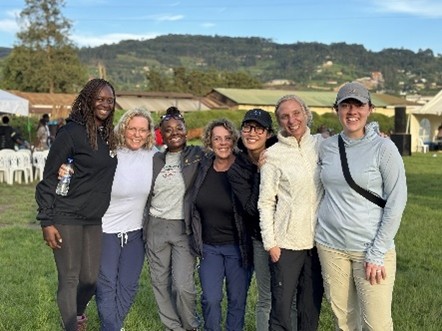 “This Thanksgiving season, I am especially grateful for the nearly five years I have been involved with Bridge of Life. What began as a curiosity-driven journey—participating as a teammate and in the Move It With Purpose program—quickly evolved into a deep partnership with Katie and the BOL team. Together, we engaged teammates in service with BOL, organizing projects at two DaVita Villagewides and advocating for team involvement at various events. Through these experiences, I came to deeply appreciate the passion, dedication, and energy of the BOL team and the incredible power of inviting others to join in their mission.
“This Thanksgiving season, I am especially grateful for the nearly five years I have been involved with Bridge of Life. What began as a curiosity-driven journey—participating as a teammate and in the Move It With Purpose program—quickly evolved into a deep partnership with Katie and the BOL team. Together, we engaged teammates in service with BOL, organizing projects at two DaVita Villagewides and advocating for team involvement at various events. Through these experiences, I came to deeply appreciate the passion, dedication, and energy of the BOL team and the incredible power of inviting others to join in their mission.
However, nothing compares to the experience of traveling with BOL on a service trip. Before November 2023, I had no idea just how extensive and vital BOL’s work truly is. During my visit to Uganda, I was confronted with the stark realities of kidney disease in regions where access to healthcare is limited. I saw firsthand the devastating impact of inadequate access to medical care. Yet, alongside the BOL team, I witnessed the transformative power of education, empowerment, and the work being done to improve lives.
Knowing that BOL’s efforts are ongoing in Kabale, Uganda and across the world fuels my excitement and commitment to stay involved. It also drives me to continue exploring how I can contribute to advancing BOL’s mission and supporting global kidney health.”
Wade McKnight (Guatemala Trip Volunteer 2024)
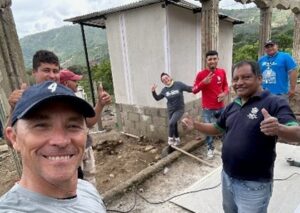 “As we enter this season of thanksgiving, I wanted to take a moment to express how Bridge of Life has been such an inspiration to me in cultivating a heart of gratitude. The work you and your team do has had a profound impact, constantly reminding me to reflect on the many blessings in my life, no matter the circumstances.
“As we enter this season of thanksgiving, I wanted to take a moment to express how Bridge of Life has been such an inspiration to me in cultivating a heart of gratitude. The work you and your team do has had a profound impact, constantly reminding me to reflect on the many blessings in my life, no matter the circumstances.
 It was truly a privilege to be part of the June Guatemala PD mission. Building the PD rooms and interacting with the families, including the children, gave me new perspective on what matters most in life. Seeing the smiles firsthand and being able to play a small role in the incredible work being done there was an experience I will always cherish. Thank you for providing opportunities for our DaVita teammates to bring hope and treatment to underserved communities around the globe. I hope to get to return on another mission very soon.
It was truly a privilege to be part of the June Guatemala PD mission. Building the PD rooms and interacting with the families, including the children, gave me new perspective on what matters most in life. Seeing the smiles firsthand and being able to play a small role in the incredible work being done there was an experience I will always cherish. Thank you for providing opportunities for our DaVita teammates to bring hope and treatment to underserved communities around the globe. I hope to get to return on another mission very soon.
Wishing you, and everyone at Bridge of Life, a season filled with peace, joy, and an abundance of gratitude.”
Delores Marquez (Guatemala Trip Volunteer 2024)
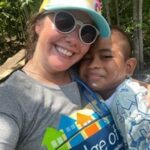 “During my BOL experience, I was thankful/grateful that the families we helped had a strong community in their remote areas. These families are going through a lot of stress and pain with their sick children, but they came together as a community and family which is beautiful. This made me want to focus on that even more here in the states.”
“During my BOL experience, I was thankful/grateful that the families we helped had a strong community in their remote areas. These families are going through a lot of stress and pain with their sick children, but they came together as a community and family which is beautiful. This made me want to focus on that even more here in the states.”
Spencer Hodge (Haiti Trip Volunteer 2018)
 “I’m grateful to have found Bridge of Life. It connected me to a community of people committed to making an impact in the lives of people suffering from chronic diseases.
“I’m grateful to have found Bridge of Life. It connected me to a community of people committed to making an impact in the lives of people suffering from chronic diseases.
I remember working in Haiti in October 2018. Our team was a mix of physicians, nurses, pharmacists and ordinary people like me; from all over the world; with no two stories the same. But we found common inspiration in the work of BOL and giving back. It was inspiring to be a part of, and that feeling keeps me coming back!”
Ana Fernandes (Guatemala Trip Volunteer 2023)
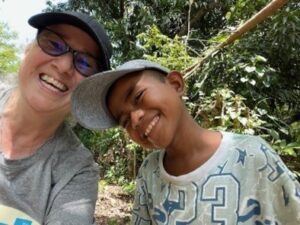 Gratitude. Emotion. Appreciation. Three words to show how grateful I am and will always be when I accepted volunteering for a week in Guatemala. I can’t put into words how grateful I am…I am pretty sure most of my best moments at DaVita involve BOL.
Gratitude. Emotion. Appreciation. Three words to show how grateful I am and will always be when I accepted volunteering for a week in Guatemala. I can’t put into words how grateful I am…I am pretty sure most of my best moments at DaVita involve BOL.
Melissa Hrdlicka (Uganda Trip Volunteer 2024)
 “I don’t have a favorite moment in particular, but when I reflect on what BOL and my trip to Uganda in 2023 means to me and to furthering the BOL mission, one quote comes to mind that reminds me of the true essence of what BOL enables individual people like me to be a part of.
“I don’t have a favorite moment in particular, but when I reflect on what BOL and my trip to Uganda in 2023 means to me and to furthering the BOL mission, one quote comes to mind that reminds me of the true essence of what BOL enables individual people like me to be a part of.
“A waterfall starts with just one drop of water, and look what comes from that!” ~Author unknown
We are all but just 1 drop of water, and each drop put together is when we can have a profound waterfall effect on the world.
This #GivingTuesday, you can save the lives of children in Kurdistan!

Imagine a world where a simple lack of resources determines life or death for a child. This is a heartbreaking reality for children in Kurdistan suffering from chronic kidney failure. A few months ago, Bridge of Life learned about a two-week old baby in Erbil who developed acute kidney injury and severe hyperkalemia. Tragically, he didn’t survive because he didn’t have access to peritoneal dialysis (PD).
Right now, there is no pediatric dialysis clinic in the entire region for children age 6 and below, meaning that without access to treatment, children and families are faced with life-or-death decisions.
Bridge of Life is committed to changing this reality. BOL’s Director of Technical Operations traveled to Kurdistan to provide an assessment and discuss the opportunity to help pediatric renal failure patients. In partnership with the Ministry of Health – Kurdistan, the Department of Health – Erbil, and Helping Hands Intl., we are establishing the first-ever pediatric dialysis unit in Kurdistan!
Bridge of Life did not budget for the Kurdistan project, but because of the urgency of the need, we want to respond. To do so, we need your help! We have a budget shortfall of $50,000 to support critical consumable supplies, essential equipment, and the safe transport of these resources to Erbil. Our timeline is to complete the critical peritoneal dialysis (PD) unit by late March and set up the hemodialysis (HD) unit mid-year.
By supporting Bridge of Life this #GivingTuesday, you can help bring dialysis and care to children and families left without options, in a place that few organizations are willing to go. Your donation means more than supplies; it means life, opportunity, and hope.
This #GivingTuesday, be part of the change and help Bridge of Life provide vital kidney care where it’s needed most. Please join us Tuesday, December 3 and bring life-saving care to Kurdistan.
How to give on December 3rd
- Triple your donation on Ripples! On December 3rd, DaVita will match all teammate donations with 2-to-1 matches in the Ripples platform, up to $2,500 per person. Login to Ripples here.
- Donate to our JustGiving Campaign – Support our campaign directly & give online! There is no match here, but we encourage you to share this link with your community to expand the impact! Any contribution, no matter the size, gets us one step closer to bringing life-saving care to patients in Kurdistan!
How Providing Nutrition Education in Uganda Fed My Soul
I am living my life to the fullest! Bridge of Life (BOL) gave me the opportunity to learn, to serve and to grow spiritually during my recent volunteer experience on their chronic disease prevention mission in Uganda in March 2019.
Having access to health care is a right for everyone, especially for those with chronic illnesses. Many of the Ugandans we met had no access to health care due to the rural locations they live in and their financial situations. Many also reported not being able to afford necessary medicine. Our goal was to reach out to as many people as possible and to provide every individual with free chronic disease screening and prevention education.
 Each patient we met had a story to tell, but one patient’s story in particular touched me deeply.
Each patient we met had a story to tell, but one patient’s story in particular touched me deeply.
In a small village located near Lake Bunyonyi, we met a young man with type 1 diabetes and severe calorie/protein malnutrition. His fat and muscle depletion were clearly visible. He had traveled a very long distance by boat and came to us with the hope that we could help with his condition.
His story was hard to hear, let alone to live. He fully depended on insulin to survive, which required him to check his blood glucose daily. He had a glucometer at home but no strips to check his blood sugar. His daily calorie intake was estimated around 400 to a maximum of 600 kcal (the average for a male is 2,500 kcal!), and his only source of protein was half a cup of beans per day. He could not afford eggs or fruits and vegetables. For those of us in the dietetic field, we certainly understood the severity of his condition.
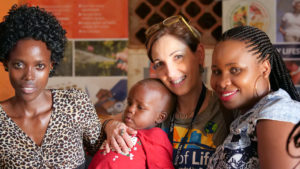 With the help of a local translator, we were able to educate him on the signs and symptoms of high and low blood sugar levels. The translator happened to have connections to local health care facilities and offered to refer him to a clinic in a nearby town. I felt so happy and fulfilled knowing that he was not returning to his village empty-handed! We were able to return the hope that he came to us with. And I now remind myself every day that this patient’s story could easily be MY, or anyone else’s, story.
With the help of a local translator, we were able to educate him on the signs and symptoms of high and low blood sugar levels. The translator happened to have connections to local health care facilities and offered to refer him to a clinic in a nearby town. I felt so happy and fulfilled knowing that he was not returning to his village empty-handed! We were able to return the hope that he came to us with. And I now remind myself every day that this patient’s story could easily be MY, or anyone else’s, story.
This quote from Lilla Watson, an indigenous Australian, was presented to our team on day one of our mission, and it rang very true by the final day of the trip: “If you have come here to help me, you are wasting your time, but if you have come because your liberation is bound up with mine, then let us work together.”
I know we touched many people’s lives on this mission. But what is even truer is how much the Ugandan people impacted the core and souls of OUR beings. I hope that my story touches YOU to the core. And if it does, I encourage you to get involved, to get out of your comfort zone and to join BOL in serving humanity!
A People’s Resilience: The Importance of Serving Syrian Refugees
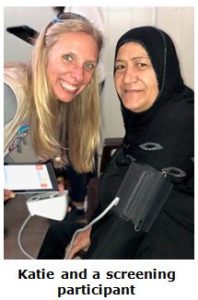 Before Bridge of Life (BOL)’s mission to Jordan in April 2018, I thought of the Syrian conflict as a distant global problem. I didn’t consider the individual story of each Syrian and I overlooked the fact that, given their circumstances, they far too often don’t have opportunities to represent themselves. The conflict isn’t given the same coverage it used to have – or maybe our ears are just going deaf to their continual crisis. After completing this mission, I felt a sense of responsibility to share some of what I learned and witnessed.
Before Bridge of Life (BOL)’s mission to Jordan in April 2018, I thought of the Syrian conflict as a distant global problem. I didn’t consider the individual story of each Syrian and I overlooked the fact that, given their circumstances, they far too often don’t have opportunities to represent themselves. The conflict isn’t given the same coverage it used to have – or maybe our ears are just going deaf to their continual crisis. After completing this mission, I felt a sense of responsibility to share some of what I learned and witnessed.
Like most people that BOL serves, the Syrian refugees that visited our mobile clinic live in extreme poverty. They often live together with dozens of other people in small apartments, shacks or tents. Hygiene is difficult – some don’t have running water or electricity. Zaatari, the main camp in Jordan, is in the desert where many plants or animals can’t even survive. But back in Syria, the refugees’ lives were much different.
Many of the patients we served were teachers, doctors, graphic designers, lawyers, engineers, and store owners. Some had homes, cars and businesses. Their children went to school and had ambitions to secure important jobs. Some people we screened already had in-depth knowledge about the chronic illnesses we were testing for. They would see their blood pressure reading, for example, and say, “Oh, that’s too high. It must be from the stress.” The consequences of the war came to life for our volunteer team – people fled Syria to save their families’ lives. They kissed the walls of their homes goodbye as they escaped to get their families to safety.
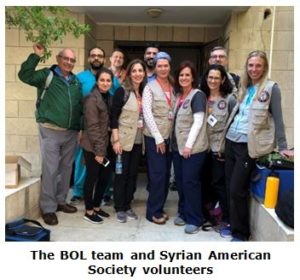 The circumstances that our patients faced in Syria were beyond my comprehension. In 2010, what started as peaceful demonstrations ended in civil war. Homes and schools in the cities were bombed, and people often fled to the countryside where there was no food, water or electricity. Parents were afraid to send their children to school. It was commonplace for children to hear explosions and witness death.
The circumstances that our patients faced in Syria were beyond my comprehension. In 2010, what started as peaceful demonstrations ended in civil war. Homes and schools in the cities were bombed, and people often fled to the countryside where there was no food, water or electricity. Parents were afraid to send their children to school. It was commonplace for children to hear explosions and witness death.
We visited one organization called Souriyat Across Borders that serves amputee children impacted by the war. We treated people who the war had left with severe burns or crooked legs. Young or old, everyone seemed utterly exhausted.
We served one man who had to leave all his belongings when he came to Jordan. He didn’t even have time to take his shoes and arrived in Jordan wearing flip-flops. Today, he and his family are living in Irbid with nothing. One volunteer commented to the man on how difficult this time must be for his family. But the man responded, “I just thank God that we are okay.” The resilience we encountered from patients was 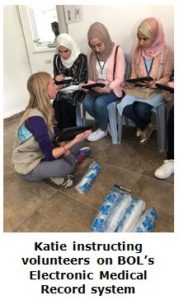 astounding! Still, countless other people I spoke to were separated from their families. One woman cried, “How can I start over when my daughter is still there?” Many patients shared photos of loved ones with us, and almost everyone had friends and family that died in the war. Sometimes people didn’t know if their loved ones were dead or incarcerated.
astounding! Still, countless other people I spoke to were separated from their families. One woman cried, “How can I start over when my daughter is still there?” Many patients shared photos of loved ones with us, and almost everyone had friends and family that died in the war. Sometimes people didn’t know if their loved ones were dead or incarcerated.
On the evening of our last day in clinic, our team (which included a group of Syrian doctors and medical students) went to a traditional Syrian restaurant for dinner. The restaurant had a live band that filled the room with Syrian music, perhaps some of the most beautiful music I’d ever heard. It didn’t take long for all the Syrians to join together in song and dance, and there was this overwhelming sense of belonging. It was truly a sublime moment.
After this trip, I no longer think of pity when I think of the Syrian refugees. Instead, I think of people leaving Syria in search for dignity and safety. And I think of courage, resilience and the will to thrive.
Humanity and Hope: My Experience Screening Syrian Refugees in Jordan
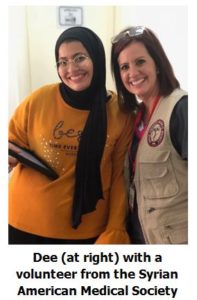 I’ve participated in previous Bridge of Life (BOL) missions, but the Jordan screening I attended in April 2018 evoked the most emotions for me. In partnership with the Syrian American Medical Society, our volunteer team of eight DaVita Kidney Care teammates screened over 1,000 displaced Syrian refugees for chronic diseases, including hypertension, diabetes and kidney disease. This mission was so different because of the population’s history of all they have been through and continue to endure.
I’ve participated in previous Bridge of Life (BOL) missions, but the Jordan screening I attended in April 2018 evoked the most emotions for me. In partnership with the Syrian American Medical Society, our volunteer team of eight DaVita Kidney Care teammates screened over 1,000 displaced Syrian refugees for chronic diseases, including hypertension, diabetes and kidney disease. This mission was so different because of the population’s history of all they have been through and continue to endure.
The people of Syria have suffered far more than I could EVER imagine in my lifetime. Their homes have been destroyed. They have lost loved ones. Some of their family is still back in Syria, and they have no hope of reuniting. They can’t go home when they have nothing to go back to, no resources to rebuild and when it’s not safe to return.
 But I could see the impact that our mission and our volunteers had on the men, women and children who came to our screening. Despite the safety they found in Jordan, the refugees struggle to make ends meet every day and to provide for their families. This mission provided them with basic healthcare services they no longer have access to. And it reminded them that they are still people in this world who care about their health and happiness.
But I could see the impact that our mission and our volunteers had on the men, women and children who came to our screening. Despite the safety they found in Jordan, the refugees struggle to make ends meet every day and to provide for their families. This mission provided them with basic healthcare services they no longer have access to. And it reminded them that they are still people in this world who care about their health and happiness.
During my time in Jordan, I saw smiling faces of men, women and children. I saw people making the best of their situation with grace. I remembered receiving hugs, kisses and numerous invitations to visit the refugees’ “homes” for dinner and to visit them if I ever came back. I remembered one man who called his American friend and let me talk to him just because we both are American and speak English. I recalled how I saw one man carrying his son with special needs over his shoulder just so he wouldn’t have to leave him alone while he and his wife attended the screening. I saw babies of all ages – a reminder of how these people would continue to thrive despite all they had 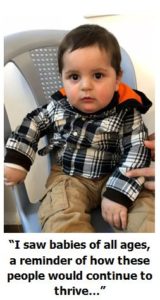 endured. Life has a way of going on!
endured. Life has a way of going on!
What we accomplished on this mission seemed so small compared to a need that is so great, but to the refugees, it meant so much. A smile, a hug, a laugh, a sticker for a child…showing them a little kindness and respect made more of an impact with them than anything else. And the opportunity for them to check on their health, meet with a physician and receive health education – it was such a simple act on our end but an incredible gesture for them. They are survivors!
My cup is so full right now that I can’t even describe how I truly feel. BOL has done wonderful things, but this is, in my opinion, the most important mission they have ever completed. I am so thankful that I got to be a part of it and would do this full-time if I could. I am grateful and proud to work with an organization that provides healthcare to those most in need around the world and can’t wait to go back. Just tell me when!
What I Learned from Educating Guatemalan Coffee Farmers on Kidney Disease Prevention
I signed up with Bridge of Life (BOL) as a volunteer because I felt the need to do something with extra meaning in my life. As a younger woman, I had the chance to travel South America and dabbled a bit in family planning and breastfeeding education, and, boy, did I feel an enormous sense of reward. So I was thrilled when I received a call for an interview from BOL and even more thrilled when I found out the mission would be to Guatemala.
I had visited Guatemala about 20 years ago, just as their civil war was ending. I was a tourist inspired by the love of beautiful textiles, the Incaparina case study in college (a study on nutrition) and my Guatemalan friends and patients in Los Angeles. They expressed their love of country with a mixture of pride and sadness for the conditions they fled back home. I had to experience Guatemala for myself. As I travelled from the most “touristy” places, such as Tikal, to some of the smallest towns in Huehuetenango, I kept telling myself I would come back some day but in a different capacity. I hoped to put a little grain of sand in the construction of a brighter future for those who struggle to create a better life for their families. I have been fortunate enough all of my life to have food, clean water, a home, access to healthcare, and more, so this opportunity was a reminder of how many people in this world still live in poverty and do what is needed to survive.
The experience on the coffee farm in Guatemala was very personally rewarding, a dream come true and then some. Our days on this chronic kidney disease screening mission started early, with station set-up at designated locations. Shortly after, the flow of patients started and didn’t stop until the last person was seen, usually in the late afternoon. I helped a for a short time at the registration desk but was then assigned to the preventative education station, where I would remain all three days having one of the best times of my life, despite how exhausted I was.
I felt that the participants were highly appreciative to learn their screening test results and information on how to better maintain their kidney health. And I trusted that most people who I saw would make at least some change in their lives and that of their families based on this education. Sometimes those small changes can make a great difference in the long run, and that belief fueled my energy to do justice to their needs.
As with most education, I also began to learn new things even as the teacher, but in this case the lessons were so very humbling. When I tried to educate on drinking more water, I learned that not all water is “equal.” There is “pure water,” and then there is gaseosa or “Coke water” – the preferred drink since most of the workers have limited access to good drinking water. And, if you are going to buy bottled water, you might as well get the sweet stuff and get some pleasure out of it (and for most, some much needed calories). When I tried to teach about integrating more vegetables into diets, I learned the names of the green, leafy vegetables that these individuals consume and that most people really enjoy them, but there is not enough water to grow them at home, and vegetables from the market often spoil within two days. When I tried to talk about the need for protein, I learned that most eat “vegan,” but only by necessity, not by choice. And I learned that one chicken can feed 10 people but is a luxury meal that’s reserved for once a week (maybe).
When I tried to educate participants about their lab results, I learned that many individuals had never even seen a doctor, and if they had, that lab tests and results were never explained to them (if they even received any tests at all). As I continued to provide preventative education, I learned that these individuals appreciated silly jokes by shyly laughing as I tried to make them feel more comfortable in a didactic environment that they were unfamiliar with. Getting a formal education is not much of an option in a society where people are put to work at a very early age to help their family survive.
But perhaps the greatest thing I learned is that, despite their struggles, the rich Mayan culture of these people shines through. With only a few handfuls of beans and some corn tortillas to sustain them, the women wrap themselves in their beautiful, colorful huipiles, the men prepare themselves for the day, and they all make the long, daily trek to the coffee farm motivated by the love of their children and families.
A Stirring Reality: Screening Guatemalan Coffee Farmers for Kidney Disease
 Chronic kidney disease is becoming a common illness in rural areas of Guatemala and particularly for agricultural workers due to factors such as long workdays, limited access to proper hydration and work labor.
Chronic kidney disease is becoming a common illness in rural areas of Guatemala and particularly for agricultural workers due to factors such as long workdays, limited access to proper hydration and work labor.
As part of our Screening & Prevention Program, Bridge of Life (BOL) is working with in-country partners to provide chronic kidney disease screenings to different agricultural workers, such as coffee farmers and banana plantation workers, in Guatemala. In March 2017, BOL and a team of volunteers traveled to Antigua, Guatemala and screened over 800 coffee farmers and their families for chronic kidney disease over World Kidney Day at Bella Vista Farm.
Read about our team’s firsthand experiences in the field, conversations with the coffee farmers and our volunteers’ own personal stories in our blog series from this mission, A Stirring Reality: Screening Guatemala Coffee Farmers for Kidney Disease. Check out the first two chapters, and stay tuned for future chapters announced on our Facebook page!
Chapter 1
“Screening in Guatemala: A Firsthand Account of the Daily Lives of Coffee Farmers,” by Katie Chandler, Program Director of Operations, Bridge of Life
Chapter 2
“True Life: I Work on a Coffee Farm,” by Jesse Casco, Patient Care Technician, DaVita Kidney Care
